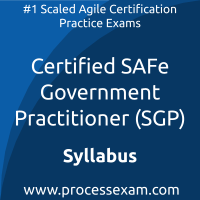 To achieve the professional designation of SAFe Government Practitioner from the SAFe, candidates must clear the SGP Exam with the minimum cut-off score. For those who wish to pass the SAFe Government Practitioner certification exam with good percentage, please take a look at the following reference document detailing what should be included in SAFe Government Practitioner Exam preparation.
To achieve the professional designation of SAFe Government Practitioner from the SAFe, candidates must clear the SGP Exam with the minimum cut-off score. For those who wish to pass the SAFe Government Practitioner certification exam with good percentage, please take a look at the following reference document detailing what should be included in SAFe Government Practitioner Exam preparation.
The SAFe SGP Exam Summary, Sample Question Bank and Practice Exam provide the basis for the real Certified SAFe Government Practitioner (SGP) exam. We have designed these resources to help you get ready to take SAFe Government Practitioner (SGP) exam. If you have made the decision to become a certified professional, we suggest you take authorized training and prepare with our online premium SAFe Government Practitioner Practice Exam to achieve the best result.
SAFe SGP Exam Summary:
| Exam Name | SAFe Government Practitioner |
| Exam Code | SGP |
| Exam Fee |
First attempt included in the course registration fee if taken within 30 days of course completion. Each retake or attempt past the 30-day window is $50. |
| Exam Duration | 90 Minutes |
| Number of Questions | 45 |
| Passing Score | 33/45 (73%) |
| Format | Multiple Choice Questions |
| Books / Trainings |
SAFe for Government SAFe Training Class Books |
| Schedule Exam | SAFe |
| Sample Questions | SAFe Government Practitioner Exam Sample Questions and Answers |
| Practice Exam | Certified SAFe Government Practitioner (SGP) Practice Test |
SAFe Government Practitioner Syllabus Topics:
| Topic | Details | Weights |
|---|---|---|
| Advance Lean-Agile in government |
- Determine the Problem to be Solved - Describe the Basic Constructs of SAFe - Describe the Basic Constructs of the Implementation Roadmap |
11% |
| Embrace a Lean-Agile mindset |
- Embrace the Lean Mindset - Support the Agile Manifesto |
7% |
| Apply SAFe Principles |
- #1 - Take an Economic View - #2 - Apply Systems Thinking - #3 - Assume Variability; Preserve Options - #4 - Build Incrementally with Fast, Integrated Learning Cycles - #5 - Base Milestones on Objective Evaluation of Working Systems - #6 - Visualize and Limit WIP, Reduce Batch Sizes, and Manage Queue Lengths - #7 - Apply Cadence, Synchronize with Cross-domain Planning - #8 - Unlock the Intrinsic Motivation of Knowledge Workers - #9 - Decentralize Decision-making - Organize around Value |
18% |
| Create high-performing teams and programs |
- Create high-performing Agile Teams - Provision the key ART roles - Coordinate and Integrate Multiple Agile Release Trains and Suppliers |
9% |
| Plan with cadence and synchronization |
- Prepare to Experience PI Planning - Create and Review Draft PI Plans - Finalize Plans and Establish Business Value - Review Final Plans and Commit to a Set of PI Objectives |
11% |
| Support program execution |
- Guide Innovation and Continuous Exploration for Programs and Large Solutions - Manage Flow of Value - Update the Program Vision and Roadmap - Define System Attributes with Features - Set Priorities with Backlog Refinement - Engage in Key SAFe Events |
7% |
| Map the path to agency and program agility |
- Build Large Programs to Align with Agency Strategy - Transition from Project to Lean flow of Epics - Adopt Lean Budgeting Aligned to Value Streams - Apply Lean Estimating and Forecasting with Cadence-based Development - Modify Acquisition Practices to Enable Lean-Agile Development and Operations - Build in Quality and Compliance - Adapt Governance Practices to Support Agility and Lean Flow of Value |
31% |
| Lead successful change |
- Lead by Example - Adopt a Lean-Agile Mindset - Lead the Change to SAFe |
6% |
Both SAFe and veterans who’ve earned multiple certifications maintain that the best preparation for a SAFe SGP professional certification exam is practical experience, hands-on training and practice exam. This is the most effective way to gain in-depth understanding of SAFe Government Practitioner concepts. When you understand techniques, it helps you retain SAFe Government Practitioner knowledge and recall that when needed.
